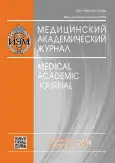ALTERATIONS IN THE MRNA EXPRESSION OF D2 DOPAMINE RECEPTOR SPLICE VARIANTS AS POSSIBLE MECHANISM OF PREFRONTAL DYSFUNCTION AFTER EARLY-LIFE IMMUNE CHALLENGE
- Authors: Schwarz AP1, Trofimov AN2, Ischenko AM3, Zubareva OE4, Klimenko VM2
-
Affiliations:
- Multidisciplinary Laboratory of Neurobiology, I.M. Sechenov Institute of Evolutionary Physiology and Biochemistry, Russian Academy of Sciences, Saint Petersburg
- Laboratory of Neurobiology of the Brain Integrative Functions, I.P. Pavlov Department of Physiology, Institute of Experimental Medicine, Saint Petersburg
- Laboratory of Protein Biochemistry, Research Institute of Highly Pure Biopreparations, Saint Petersburg
- Laboratory of Molecular Mechanisms of Neuronal Interactions, I.M. Sechenov Institute of Evolutionary Physiology and Biochemistry, Russian Academy of Sciences, Saint Petersburg
- Issue: Vol 19, No 1S (2019)
- Pages: 109-111
- Section: Articles
- Published: 15.12.2019
- URL: https://journals.eco-vector.com/MAJ/article/view/19352
- ID: 19352
Cite item
Abstract
Various detrimental factors during early life may affect CNS development and increase risk of neuropsychiatric symptoms in later life. Disruption in brain dopaminergic system maturation is believed to be one of the mechanism of different neurodevelopmental disordrers. In this article we review behavioral peculiarities and changes of prefrontal D2 dopamine receptor splice variants (D2S and D2L) expression in rats after chronic experimental increase of proinflammatory cytokine interleukin(IL)-1β during 3rd week of life. Early life IL-1β treatment produce long lasting working memory deficit originating in juvenile adult animals. Elevation of IL-1β during 3rd week of life also affect developmental expression of D2 dopamine receptor mRNAs leading to increased D2S/D2L ratio in the medial prefrontal cortex of adolescent but not adult rats. Early life IL-1β treatment cancelled the learning-induced D2L mRNA downregulation during active avoidance conditioning in adult rats. Thus, dysregulation of expression of distinct D2 dopamine receptor splice variants within medial prefrontal cortex is supposed to be implicated in cognitive decline caused by early life immune challenge.
Full Text
About the authors
A P Schwarz
Multidisciplinary Laboratory of Neurobiology, I.M. Sechenov Institute of Evolutionary Physiology and Biochemistry, Russian Academy of Sciences, Saint Petersburg
A N Trofimov
Laboratory of Neurobiology of the Brain Integrative Functions, I.P. Pavlov Department of Physiology, Institute of Experimental Medicine, Saint Petersburg
A M Ischenko
Laboratory of Protein Biochemistry, Research Institute of Highly Pure Biopreparations, Saint Petersburg
O E Zubareva
Laboratory of Molecular Mechanisms of Neuronal Interactions, I.M. Sechenov Institute of Evolutionary Physiology and Biochemistry, Russian Academy of Sciences, Saint Petersburg
V M Klimenko
Laboratory of Neurobiology of the Brain Integrative Functions, I.P. Pavlov Department of Physiology, Institute of Experimental Medicine, Saint Petersburg
References
- Zubareva OE, Klimenko VM. Increases in proinflammatory cytokine levels at early ages as a risk factor for the development of nervous and mental pathology. Neuroscience and Behavioral Physiology. 2013;43(4):535-541.
- Zubareva OE, Shcherbakova KP, Kalemenev SV, et al. Impairments to conditioned reflex activity in adult rats after administration of interleukin-1β during early postnatal ontogeny. Neuroscience and Behavioral Physiology. 2013;43(2):210-213.
- Beaulieu J-M, Espinoza S, Gainetdinov RR. Dopamine receptors - IUPHAR Review 13. British Journal of Pharmacology. 2015;172(1):1-23.
- Zhang Y, Bertolino A, Fazio L, et al. Polymorphisms in human dopamine D2 receptor gene affect gene expression, splicing, and neuronal activity during working memory. Proc Natl Acad Sci U S A. 2007;104(51):20552-20557.
- Schwarz AP, Rotov AY, Chuprina OI, et al. Developmental prefrontal mRNA expression of D2 dopamine receptor splice variants and working memory impairments in rats after early life Interleukin-1β elevation. Neurobiology of Learning and Memory. 2018;155:231-238.
- Zubareva OE, Eliseeva AP, Simbirtsev AS, Klimenko VM. The effects of proinflammatory cytokines on the formation of behavior in early postnatal ontogenesis. Neuroscience and Behavioral Physiology. 2006;36(4):367-372.
- Schwarz AP, Trofimov AN, Zubareva OE, et al. Prefrontal mRNA expression of long and short isoforms of D2 dopamine receptor: Possible role in delayed learning deficit caused by early life interleukin-1β treatment. Behavioural Brain Research. 2017;333:118-122.
Supplementary files







